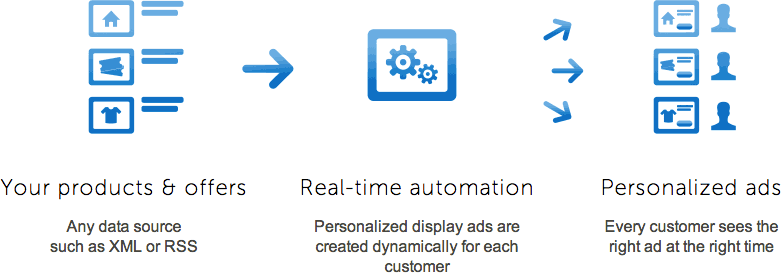Online advertising could use some simplification. Anybody that has spent more than two months working in the online advertising space will tell you that it is a fast-paced, complex, confusing, always changing, and exhausting industry that has few, if any, dedicated rules, set procedures, or processes that everybody agrees with and follows. Even companies offering the same services use different names to refer to the same thing: online advertising, Internet marketing, display advertising, and so on. Luckily, some companies are dedicating themselves to making certain tasks a little simpler. San Francisco-based start up Canned Banners is an example of such a company, not to mention their expertise in dynamic ads.
Simpler Tools for Easier Advertising
Since 2009, Canned Banners has been automating display ad design. Its self-serve tools help you build professional quality display ads quickly and cheaply, without requiring design or development knowledge. Its service makes display advertising cheaper and easier for everyone from local businesses to Fortune 500 companies. While this sounds potentially useful, what Canned Banners is planning to roll out next might strike a chord among a larger audience within the online advertising industry.
During Q1 2012, Canned Banners will be releasing its API (which has been in private beta since mid-2011) that provides ad networks, agencies, and corporate advertisers with flexible development tools that transform display ad design from a costly bottleneck to a scalable, streamlined service. With its API, organizations will be able to develop white-labeled ad design tools and power dynamic display ad creative.
Building a Dynamic Display Ad Campaign
OK, great – lots of fancy sounding words, but what does it actually mean? It means that with the help of Canned Banners’ API, you can easily and quickly build engaging dynamic ads that are actually relevant to the end user. You don’t have to be dependent on in-house designers trying to build 50 new creative sets a week or outsourcing to some expensive third-party creative house. You can be in control of utilizing available customer data in a fast and accurate way that produces high quality and engaging dynamic ads.
Displaying the right offers for the right customers at the right time is easier said than done. To do the job right, advertisers need the ability to take the different data points (e.g., gender, income, geo-location, etc.) of what makes up their ideal customer and combine them with the types of potential websites their customers are visiting (e.g., travel sites, blogs, user-generated content, forums, etc.) and utilize all of this data in real time to create dynamic ad creatives that are engaging to the customer and motivate them to look, click, and ultimately buy.
To have any hope of doing this successfully, you’re going to have to examine and combine several different customer data points at the same time. This is where Canned Banners’ API comes into play and makes your life easier and your campaigns more successful.
A few things to keep in mind:
Be careful of data overload. There’s a ton of data to deal with here, so realize it might take a little bit of patience and testing to get your creatives and campaign dialed in and optimized. In addition to all of the actual customer data to manage (e.g., age, income, gender, geo-location, etc.), you have creative data (e.g., size, layout, look, feel, color, animation, etc.) and media buying data (e.g., which websites to target, banner location, media costs, time of day performance, etc.).
With so many data points in the mix, it’s going to take some time to get it right. That said, don’t underestimate the importance of setting proper expectations with the client ahead of time. The end result will most likely be very positive; just don’t pull your hair out during the process because your client is expecting magic results within the first 24 hours of the campaign’s launch. Lots of flexibility and data can be exciting, useful, and rewarding, but at the same time it can be overwhelming, stressful, and cumbersome. Make a strategic plan ahead of time and set proper expectations and timelines for the client.
Make every impression count; tailor every ad to the customer. Every customer is unique, so why show everyone the same ad? Your display advertising should work to match your customers’ interests and needs with your products and services. Real-time display advertising targets each customer with individually-tailored offers. This results in being able to display ad creatives that are relevant and effective. By properly combining customer data points with a dynamic ad creation solution, you should be able to bring your display campaigns to life with offers, messages, and products that are always fresh and relevant. At the end of the day, don’t limit your campaign with “one-size-fits-all” ads, because you aren’t trying to sell sweatpants at a mall. Well, maybe you are selling sweatpants, in which case, a dynamic creative solution will still potentially help you sell more.
Sample Use Cases
Travel and leisure. Automatically promote the latest offers, pricing, and availability without having to manually design, create, and upload new sets of ads. This helps you avoid displaying an ad for a sold-out trip, which can be frustrating for the customer and decrease their confidence in your service.
Real estate. Automatically show potential home buyers nearby listings, descriptions, and photos. You will avoid showing a generic creative of a house for rent outside the customer’s location, which is less enticing and relevant to the customer.
Daily deals. Channel the right deals to the right customers with geographic and demographic targeting. There’s no reason to waste budget on displaying ads to customers outside your company’s geographic reach.
E-commerce. Retarget lost site visitors with the precise products and categories they previously browsed, showing current pricing and availability. This is much more engaging than showing a customer a generic ad for your e-commerce website versus a creative displaying the last four products the customer browsed.
This article was originally published by Tim Nichols on February 29, 2012 at ClickZ.com
Related article: “How to use customer data in dynamic ad campaigns”



